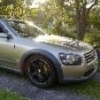M35 Stagea intake suction pipe
Announcements
-
Similar Content
-
Latest Posts
-
Just don't use ChatGPT or any other artificial stupidity for the equivalent of googling. Their demonstrated inability to discriminate reality from hallucination should be enough to make them totally untrusted. LLMs don't know anything and cannot think to even the smallest extent. They are just predictors of the next word, and that should never be confused with capability.
-
I think, given the usage model described in the OP, I'd never ever experience the wonders of the 400kW upgrade. What I really need is boost from 2000rpm and probably no more than 260-270rwkW. But I suspect that the highflow is not actually the turbo for that purpose, so I may in fact need to get a G25 or 30 or something right sized and very spooly. We shall see after it is tuned. I've had to back the boost and boost ramp off to stop the thing from pinging since the highflow went on, so I've been almost living the NA life for 9 months now! Injectors are recently in hand. AFM is in hand. Dyno is fixed. Just need to clear a queue of f**king Supras out of the way (and probably fit my new gearbox). So....some time this year? Lol.
-
For what I gather is a Sunday/summer car....braided is fine. You're not going to be left without a vehicle and you have plenty of time for inspection/maintenance. Oof. I wouldn't use them that way. They can probably handle the temperature** but the internal corrugations means that their flow characteristics are a bit shit. Lots of extra friction and pressure loss. Makes them flow like the next pipe size down. ** They are stainless, and the stainless can usually be at least something like 304L, which is pretty good at higher temperatures (unlike 316L, which I would use for a wrt/corrosive environment, but not a particularly hot environment). But the welding needs to be top notch. And even then, because you usually need at least one cone-seat end on them (because you can twist the hose and do up both ends at the same time unless one of them is a union) they can be prone to coming loose with heat cycles.
-
I don't have the OEM oil feed lines though and the turbo-wraparound line is torn, only has water. My plan is to get replacements for these and just connect a braided line to there. And make sure it's leak free. Hoses like these are also sometimes used to connect external wastegates, so for an EGR I think you're good using them.
-
Alright I understand. The most likely case is probably gonna be that I just keep the OEM unit in the car as long as it works.
-






Recommended Posts
Create an account or sign in to comment
You need to be a member in order to leave a comment
Create an account
Sign up for a new account in our community. It's easy!
Register a new accountSign in
Already have an account? Sign in here.
Sign In Now